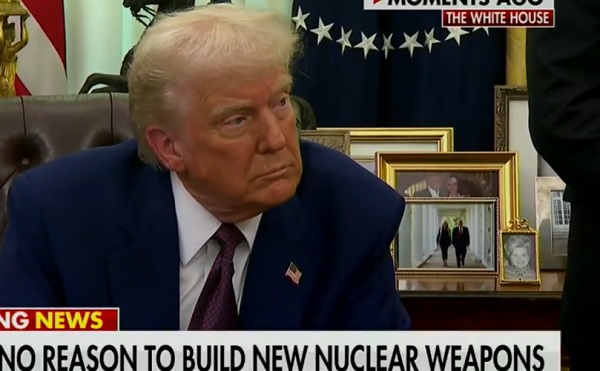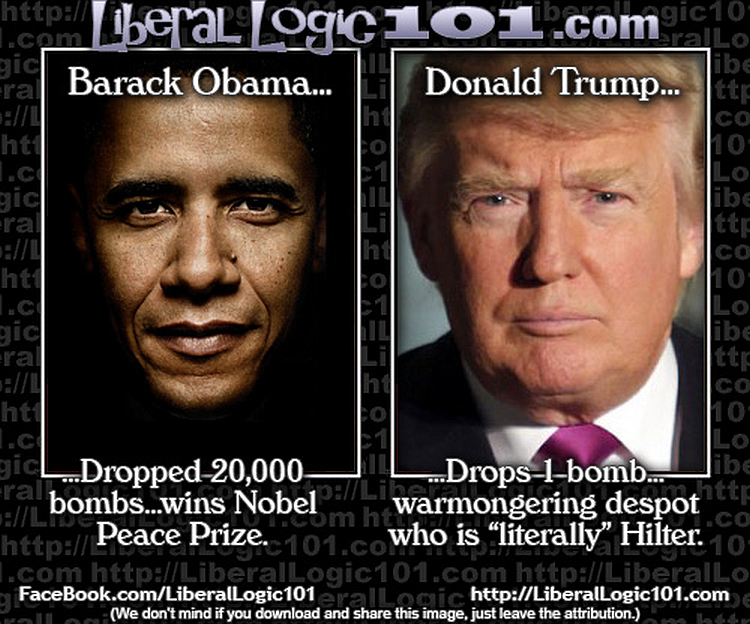conflict
Trump proposes US, Russia, China scale back nuclear weapons and military budgets

From LifeSiteNews
By Stephen Kokx
The U.S. president is focusing not only on a resolution in Ukraine but bringing peace to the world while pivoting away from Europe.
As the Trump administration’s foreign policy begins to take shape, political observers are looking for clues as to what the next four years will look like. Remarks Donald Trump made while in the Oval Office this week about Russia and China are helpful in this regard.
While seated behind the Resolute Desk — with a portrait of Ronald Reagan hanging over his left shoulder — Trump encouragingly told reporters that “one of the first meetings I want to have is with President Xi of China, President Putin of Russia, and I want to say, ‘let’s cut our military budget in half.’ And we can do that.”
Trump exuberantly added, “President Putin and I agreed that we were going to be (de-nuclearizing) in a very big way … we already have so many you could destroy the world 50 times over, 100 times over.”
Trump’s comments came after he had spoken to Putin by phone, a call where they also agreed to “start negotiations immediately” to end the Ukraine conflict.
Trump’s desire to engage with — as opposed to simply attack — two countries that have long been described as America’s biggest adversaries is a breath of fresh air as it shows he is willing to break with past (failed) operating procedures that have done nothing but increase profits for defense contractors and have heightened the likelihood of a world war breaking out.
At present, the U.S. military has an annual budget of around $850 billion. That is roughly the size of the next nine largest militaries in the world combined. For comparison’s sake, Russia and China purportedly spend $145 billion and $290 billion each year, respectively, on defense.
The U.S. and Russia currently account for the vast majority of the world’s nuclear weapons, collectively owning 11,000. Fox reported that the U.S. has 3,748 nuclear warheads as of September 2023. In the late 1980s, that number was a whopping 22,217. Russia reportedly has 4,380, and China possesses around 600.
A coup for freedom
Trump’s remarks can only be appreciated within the context of recent developments. Not only has the president begun the dismantling of USAID, he instructed his Secretary of Defense and Vice President to put the world on notice that he intends to realign the U.S. toward a more hemispheric focus within a multi-polar world.
Speaking in Munich on Friday, Vice President JD Vance informed European technocrats that their decades-long, U.S.-subsidized vacation from self-reliance has come to an end.
“It’s important in the coming years for Europe to step up in a big way to provide for its own defense,” Vance told a stunned crowd.
“The threat that I worry the most about vis-a-vis Europe is not Russia, it’s not China, it’s not any other external actor … what I worry about is the threat from within; the retreat of Europe from some of its own fundamental values.”
Vance’s remarks were not well received. Liberal German Defense Minister Boris Pistorius whined that “this is not acceptable,” a comment that prompted anti-war activist Daniel McAdams and Republican U.S. Sen. Mike Lee of Utah to call on the United States to leave Europe behind altogether.
Vance followed his historic broadside by holding a meeting with Ukrainian President Volodymyr Zelenskyy. Early reports indicate that Vance essentially told him to pound sand. Curt Mills of The American Conservative shared the following crucial observation on X:
Secretary of Defense Pete Hegseth delivered an equally forceful message at NATO headquarters in Brussels this past week.
“The United States does not believe that NATO membership for Ukraine is a realistic outcome of a negotiated settlement,” he said, shattering the dreams of globalists around the world.
If Trump is successful in bringing peace to Ukraine and if he negotiates a lasting deal with Russia and China — all while defanging the U.S. Deep State and stopping the war in the Middle East — he will have accomplished what no other modern president has ever done, and would be entirely deserving of the Nobel Peace Prize. He will have also lived up to his old 2016 promise of draining the swamp.
It’s still early, and plenty of things can go awry from now until 2028, but at this stage in the game, Trump 2.0 is shaping up to be what many of his initial supporters had hoped for the first time around.
conflict
Obama Dropped Over 26K Bombs Without Congressional Approval

@miss_stacey_ Biden, Clinton, Obama & Harris on Iran #biden #clinton #obama #harris #trump #iran #nuclear
Iran has been the target for decades. Biden, Harris, and Clinton—all the Democrats have said that they would attack Iran if given the opportunity. It appears that Donald Trump is attempting to mitigate a potentially irresolvable situation. As he bluntly told reporters: We basically — we have two countries that have been fighting so long and so hard that they don’t know what the f‑‑‑ they’re doing.”
A portion of the nation believes Trump acted like a dictator by attacking Iran without Congressional approval. I explained how former President Barack Obama decimated the War Powers Resolution Act when he decided Libya was overdue for a regime change. The War Powers Act, or War Powers Resolution of 1973, grants the POTUS the ability to send American troops into battle if Congress receives a 48-hour notice. The stipulation here is that troops cannot remain in battle for over 60 days unless Congress authorizes a declaration of war. Congress could also remove US forces at any time by passing a resolution.
Libya is one of seven nations that Obama bombed without Congressional approval, yet no one remembers him as a wartime president, as the United States was not technically at war. Over 26,000 bombs were deployed across 7 nations under his command in 2016 alone. Libya, Afghanistan, Syria, Yemen, Somalia, Iraq, and Pakistan were attacked without a single vote. Donald Trump’s recent orders saw 36 bombs deployed in Iran.
The majority of those bombings happened in Syria, Libya, and Iraq under the premise of targeting extremist groups like ISIS. Drone strikes were carried out across Somalia, Yemen, and Pakistan as the Obama Administration accused those nations of hosting al-Qaeda affiliated groups. Coincidentally, USAID was also providing funding to those groups.
The 2001 Authorization for Use of Military Force (AUMF) was initially implemented to hunt down the Taliban and al-Qaeda after the 9/11 terrorist attacks. Obama broadened his interpretation of the AUMF and incorporated newly formed militant groups that were allegedly expanding across the entire Middle East. The Bureau of Investigative Journalism believes there were up to 1,100 civilian casualties in Pakistan, Yemen, and Somalia. Thousands of civilians died in Syria and Iraq but the death toll was never calculated. At least 100 innocent people died in the 2016 attacks in Afghanistan alone.
The government will always augment the law for their personal agenda. The War Powers Resolution was ignored and the AUMF was altered. Congress was, however, successful in preventing Obama from putting US troops on the ground and fighting a full-scale war. In 2013, Obama sought congressional approval for military action in Syria but was denied. Obama again attempted to deploy troops in 2015 but was denied. Congress has to redraft the AUMF to specifically prevent Obama from deploying troops in the Middle East. “The authorization… does not authorize the use of the United States Armed Forces on the ground in Syria for the purpose of combat operations.” Obama attempted to redraft the AUMF on his own by insisting he would prohibit “enduring offensive ground combat operations” or long-term deployment of troops. He was met with bipartisan disapproval as both sides believed he was attempting to drag the United States into another unnecessary war.
The United States should not be involved in any of these battles, but here we are. Those living in fear that Donald Trump is a dictator fail to recognize that past leadership had every intention of sending American men and women into battle unilaterally without a single vote cast.
conflict
The Oil Price Spike That Didn’t Happen


From the Daily Caller News Foundation
By David Blackmon
What if they gave an oil price spike and nobody came? That is admittedly kind of a lame play on an old saying about parties, but it’s exactly what has happened over the two weeks since June 12, when Israel launched its initial assault on Iran.
At that day’s close of trading, the domestic U.S. WTI price sat at $68.04 per barrel. As of this writing on June 24, the price stands at $64.50. That’s not just the absence of a price spike, it is the opposite of one, a drop of 5% in just two weeks.
So, what happened? Why didn’t crude prices spike significantly? For such a seemingly complex trading market that is impacted daily by a broad variety of factors, the answer here is surprisingly simple, boiling down to just two key factors.
Dear Readers:
As a nonprofit, we are dependent on the generosity of our readers.
Please consider making a small donation of any amount here.
Thank you!
- Neither Israel nor the United States made an effort to target Iran’s refining or export infrastructures.
- Despite some tepid, sporadic saber rattling by Iranian officials, they mounted no real effort to block the flow of crude tankers through the region’s critical choke point, the Strait of Hormuz.
Hitting Iran’s infrastructure could have taken its substantial crude exports – which the International Energy Agency estimates to be 1.7 million barrels per day – off the global market, a big hit. Shutting down the Strait of Hormuz, through which about 20% of global crude supplies flow every day, would have been a much bigger hit, one that would have set prices on an upward spiral.
But the oil kept flowing, muting the few comparatively small increases in prices which did come about.
Respected analyst David Ramsden-Wood, writing at his “HotTakeOfTheDay” Substack newsletter, summed it up quite well. “Oil is still structurally bearish. U.S. producers are in PR mode—talking up ‘Drill, baby, drill’ while actually slowing down. Capex is flat to declining. Rig counts are down. Shareholders want returns, not growth. So we’re left with this: Tension in the Middle East, no supply impact, and U.S. production that’s quietly rolling over. Oil shrugged.”
There was a time, as recently as 10 years ago, when crude prices would have no doubt rocketed skywards at the news of both the commencement of Israel’s initial June 12 assault on Iran’s military and political targets and of last Saturday’s U.S. bombing operation. In those days, we could have expected crude prices to go as high as $100 per barrel or even higher. Markets used to really react to the “tension in the Middle East” to which Ramsden-Wood refers, in large part, because they had no real way to parse through all the uncertainties such events might create.
Now it’s different. Things have changed. The rise of machine learning, AI and other technological and communications advancements has played a major role.
In the past, a lack of real-time information during any rise in Middle East tensions left traders in the dark for some period of time – often extended periods – about potential impacts on production in the world’s biggest oil producing region. But that is no longer the case. Traders can now gauge potential impacts almost immediately.
That was especially true throughout this most recent upset, due to President Donald Trump’s transparency about everything that was taking place. You were able to know exactly what the U.S. was planning to do or had done just by regularly pressing the “refresh” button at Trump’s Truth Social feed.
Tim Stewart, President of the D.C.-based U.S. Oil and Gas Association, has a term for this. “The Markets are becoming much better at building the ‘47 Variable’ into their short-term models,” he said in an email. “This is not a Republican Administration – it is a Disrupter Administration and disruption happens both ways, so the old playbooks just don’t apply anymore. Traders are taking into account a President who means what he says, and it is best to plan for it.”
Add to all that the reality that a high percentage of crude trading is now conducted via automated, AI-controlled programs, and few trades are any longer made in the dark.
Thus, the world saw a price spike which, despite being widely predicted by many smart people, didn’t happen, and the reasons why are pretty simple.
David Blackmon is an energy writer and consultant based in Texas. He spent 40 years in the oil and gas business, where he specialized in public policy and communications.
(Featured Image Media Credit: Screen Capture/PBS NewsHour)
-

 Brownstone Institute2 days ago
Brownstone Institute2 days agoFDA Exposed: Hundreds of Drugs Approved without Proof They Work
-

 Energy1 day ago
Energy1 day agoChina undermining American energy independence, report says
-

 Business1 day ago
Business1 day agoTrump on Canada tariff deadline: ‘We can do whatever we want’
-

 Automotive1 day ago
Automotive1 day agoElectric vehicle sales are falling hard in BC, and it is time to recognize reality.
-

 Business1 day ago
Business1 day agoEurope backs off greenwashing rules — Canada should take note
-

 Automotive1 day ago
Automotive1 day agoPower Struggle: Electric vehicles and reality
-

 Business9 hours ago
Business9 hours agoCanada Caves: Carney ditches digital services tax after criticism from Trump
-

 Crime9 hours ago
Crime9 hours agoSuspected ambush leaves two firefighters dead in Idaho








